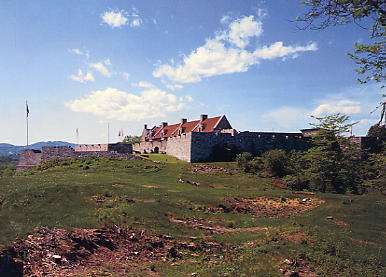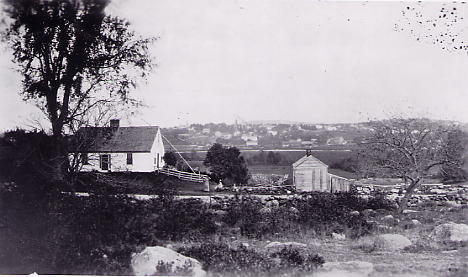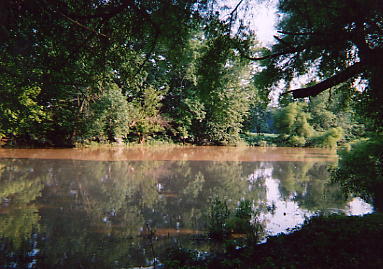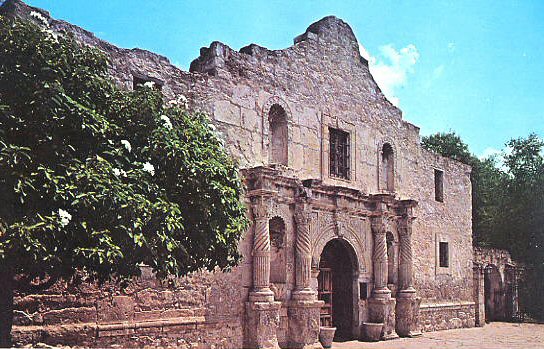Brookfield’ sons, including Moses Jennings,
grandson of Stephen Jennings (and son of Jonathan Jennings), answered the
muster roll on August 9, 1757, and raised three companies of militia as
part of a force rushed to relieve the besieged British garrison under Lt.
Colonel George Munroe at Fort William Henry. The fort stood at the foot of
Lake George, New York--a distance of over one hundred forty miles from
Brookfield (but only seventeen miles from Fort Edward on the Hudson River,
where British general Webb and nearly 4,000 troops watched and refused to
reinforce Munroe). Surrounded, and heavily outnumbered by a French force
of nearly 11,000 (regulars, civilian militia and Indian warriors from
numerous tribes) on August 3, commanded by the Marquis de Montcalm,
Munroe’s gallant stand became desperate as French mortar and artillery
pummeled the defenders from trenched positions which drew closer to the
fort each day of the siege. Montcalm had assembled his army at Fort
Ticonderoga (Carillon). Munroe’s surrender, and the subsequent “massacre”
by Indians of some of his disarmed troops and civilians, took place before
the colonial reinforcements arrived. Marching via Kinderhook under Captain
Jabez Upham, the Brookfield unit learned of Munroe’s fate and returned
home.
|

(Photo courtesy of Nathan Farb)
|
FORT TICONDEROGA--Built in 1755,
seventy-seven years after Jennings heroics on Lake Champlain, as
part of New France's network of strategic waterway strongholds, this
fort played an important role in the French & Indian War and the
American Revolution.

|
Gripping stories of duty and frontier
sacrifice passed down the Jennings generations in Brookfield. Moses' son,
Joel Jennings, enlisted at age sixteen during the Revolutionary War in
1778 and was part of a colonial force which reinforced Saratoga and
Ticonderoga a year later. Benjamin Jennings, probably an older brother or
cousin, had mustered in Brookfield on April 19, 1775, hours after
Paul Revere's ride, and marched for Lexington. Although it is unlikely the
Brookfield unit reached Lexington (or Concord) in time for the
electrifying events of that day, they reinforced the revolution at a
critical juncture and probably helped drive the Redcoats back to
Cambridge. Two months later Jennings and his unit were at Bunker Hill
where the patriots delivered General Howe's regulars a staunch, bloody
repulse before retreating when ammunition ran out. The records of North
Brookfield indicate that Benjamin had 16 1/3 months of military service by
1778 and that he re-enlisted in 1779 and 1780. He was sent to North River
and family tradition holds that Captain Hamilton built him a small house
after the war in recognition of his meritorious service.
 |
JENNINGS FARM--This hilly
spread in central Massachusetts produced dairy, pork and shoe
leather. The farm remained in the family for more than two
hundred years, nurturing many generations of farmer-soldiers,
who served in every conflict from King Philip's War through
WW1.

|
Brookfield town records reveal on May 2,
1790 Joel Jennings married Zillah Walker. Their first son, Calvin, was
born on December 16, 1792 at the family farmhouse built on land inherited
from Moses dating back to Stephen Jennings' holdings. Calvin and his
younger brother, Charles, worked the farm with their father, who died at
age 51 on October 21, 1813. Calvin was serving as a captain in the militia
during this time as part of the mobilization for the War of 1812.
Years later, Calvin's first son, Joel
Albert Jennings (1821-1873), would gather "family lore" from his
grandmother, Zillah. Joel Albert seemed interested in old, "fortified
houses" adjacent to Jennings' property and stories of his ancestors'
sacrifices on the frontier. He seemed particularly interested in the house
of Edward Walker which stood on the south side of the river, west of
Mason's brook and north of the house of William B. Hastings, his
grandfather. The Walker house, built after Queen Anne's War, belonged to
the family of Joel Albert's great grandmother, Marcy Walker (Moses
Jennings' wife).1/ By the late 1830s recollections of the colonial days
were fading and the New England Renaissance, with its emphasis on
literature, education and humanistic enlightenment was in flower. Joel
Albert's flair for history and academic discipline, supported by his
educationally-minded parents, led him to graduate Williams College (1845)
and Harvard Law School (1849). An industrious student, Joel Albert,
financed his schooling by tutoring and other assorted jobs, but made a
poor vocational choice (law) and soon gave up his legal practice in Port
Jervis, New York, captivated by the lure of California's Gold Rush and
Manifest Destiny.2/ His wife, Susan Bates Jennings and young family,
including William Nevinson Jennings (1847-1934), moved back to Brookfield
to live on the farm with Deacon Calvin Jennings/Laura Hastings and the
Elijah Bates' family of North Brookfield. Joel Albert and Susan Bates had
married in 1846, traveled and taught together in Georgia, but she refused
to follow him west. Later in life, she became a successful literary agent
in New York City. A younger brother, Calvin Walker Jennings, enlisted in
the 12th Pennsylvania Cavalry in April 1862, served as a bugler for
Company B and saw action on many key battlefields, including Second
Manassas, South Mountain,
Antietam, Gettysburg, Monocracy and the defense
of Washington (Fort Stevens). He was honorably discharged in July 1865.
3/
 |
FORT JENNINGS--Named for
Lt. Col.
William Jennings, Jr. (1771-1831) whose legendary campaigns against
Tecumseh's Indian Confederation included service under General
Anthony Wayne at Fallen Timbers (1794) and General William Henry
Harrison at Tippecanoe (1811), once stood on Auglaize River in
Northwestern Ohio. Jennings who also commanded troops in the War of
1812, spent most of his life as a farmer in Kentucky.

|
| |
|

Courtesy of Mac Miller
OLDEST HERO AT THE ALAMO
-- Gordon C. Jennings, a native of Connecticut, at age
fifty-four, was a few years senior to Davy Crockett on March
6, 1836. Both were part of the legendary garrison which died
defending Texas freedom.
|
Over the years Deacon Calvin and Laura
Hastings became among the most prominent citizens of Brookfield as the
driving forces of the town's congregational church. An account of Deacon
Calvin's life appeared in the Worcester Daily Spy newspaper on
November 15, 1887 on the occasion of Calvin's 95th year, in which he was
described as a rugged conservative, devoted to hard work. 4/
Calvin's grandson, William Nevinson
Jennings, grew up on the Jennings farm at Brookfield, which consisted of
125 acres in the 1850s, including about a dozen cows. The principal
activity was butter production for sale, but the family also produced its
own pork. William remembered his grandfather in later years as a stem
disciplinarian, but credited him with abstaining from corporeal
punishment, except once when he was "walloped for sassing a neighbor.” At
the outbreak of the Civil War, "Willie" and his brothers, Arthur Bates
Jennings and Emerson Pratt Jennings, moved to New York City where their
adventuring father, Joel Albert had secured a teaching position, having
returned from California. Later, William would build a successful printing
business and two of his sons, John Edward Jennings (1875-1945) and
Francis
Bates Jennings (1885-1957) would graduate from Columbia University's
College of Physicians and Surgeons and serve as officers in the U.S. Army
medical corps in France during World War I.
Curtis Herman Jennings (1876-1934), sole son of Civil War veteran Calvin
W. Jennings, (1842-1917), served in the US Navy during the
Spanish-American War and in WW 1. He also became a doctor and
distinguished himself as a pioneering leader in the field of radiology
(x-ray).
Notes and Additional Reading
I/ History of North Brookfield,
Massachusetts, J.H. Temple, (1887), p.169
2/ Forty Years Record of the Class
of 1845 - Williams College, (1885), pp.87-89
3/ Leather and Steel: The 12th
Pennsylvania Cavalry in the Civil War, Larry B.
Maier, (2001)
4/ Worcester Daily Spy,
November 15,1887, p.3 (Column 5)
Randolph Herald,
February 21,2002, "From Randolph to Washington", (Section B).
Springfield Union-News,
May 13, 2002, "Hatfield Raid a Story of Courage, Heroism"
In Jasper County: The First Two Hundred Years, Marvin L. VanGilder,
Carthage, Missouri, 1995, pp.16,18, 20, 31
Our 'Dances with Wolves' Ancestor, The Joplin Globe, November
15, 2004 (Andy Ostmeyer), Joplin, Missouri
"Forgotten Farmer-Soldier Remembered,"
The Central Record, Lancaster, Kentucky, June 2, 2005, pp. A7, 12.
"Hero's Grave Gets Headstone."
Danville Advocate-Messenger, May 19, 2005.
Jennings Heritage
Project
P.O. Box 5565 - Washington DC 20016 Tel: (202) 296-4563
Email: agenergy@aol.com
Cornerstone
for Courage
Stephen
Jennings : The Brookfield Years
Jennings Heritage Project
Heritage
Preservation
"Leadership
Education and Character Development Through Historical Scholarship" |